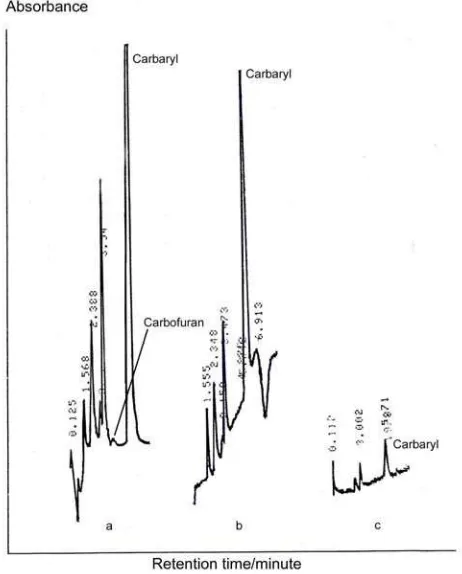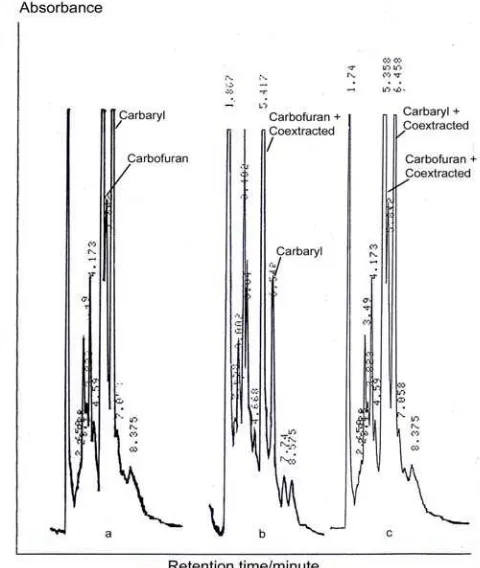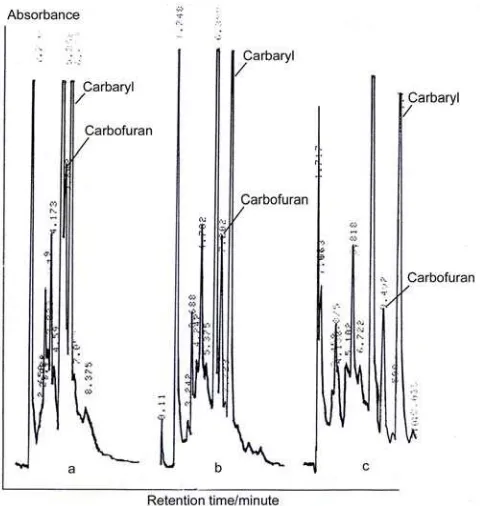EXTRACTION, CLEAN-UP, AND HPLC DETECTION OF CARBARYL AND CARBOFURAN
FROM CABBAGE (Brassica oleracea)
Iip Izul Falah
Department of Chemistry, Faculty of Mathematics and Natural Sciences, Universitas Gadjah Mada, Bulaksumur, Yogyakarta, Indonesia
Received August 31, 2009; Accepted September 29, 2009
ABSTRACT
Carbaryl (1-naphthyl-N-methylcarbamate) and carbofuran (2,3-dihydro-2,2-dimethyl-7-benzofuranol-N-methylcarbamate) are very important N-methylcarbamate pesticides due to their high insecticide and nematocide effects, and widely used in vegetables plantations. The increasing use of carbamate pesticides poses a risk to human and environment. Thus, it is necessary to quantify their residue amount in food and vegetables to prevent harmful effect on animals, human and environment. This work was aimed to study of carbaryl and carbofuran analysis from fortified cabbage (Brassica oleracea) by liquid-liquid extraction, clean-up using SPE, followed by HPLC detection. Result of the work showed that detection of carbaryl using spectrophotometer detector at wavelength of 220 nm was better than at 230 and 280 nm, respectively. When the carbamates were extracted from cabbage using methanol, followed by liquid-liquid extraction using dichloromethane, cleaned-up with SPE-C18 and eluted by acetonitrile, the recovery was 96.8%. The detection by HPLC involved 4.6 x 25 mm, 5 µm C18 column, spectrophotometer detector at wavelength of 220 nm, and isocratic mobile phase at ratio of 35:65 of acetonitrile:aquabidest gave a good separation between co-extracted compounds and the carbamates.
Keywords: HPLC, carbaryl, carbofuran, extraction, clean-up
INTRODUCTION
Carbaryl (1-naphthyl-N-methylcarbamate) and
carbofuran (2,3-dihydro-2,2-dimethyl-7-benzofuranol-N
-methylcarbamate) are very important N
-methylcarbamate pesticides. This pesticide is a class of highly effective commercial pesticides, have been used worldwide since the beginning of 1960s due to their high insecticide and nematocide effects [1]. Carbamate pesticides began to replace organochlorine such as DDT and organophosphorous pesticides due to their low environmental persistence and low toxic effect on mammalians [2]. However, carbamate pesticides are suspected carcinogens and mutagens [3] because of they are also acetyl cholinesterase inhibitors. The increasing use of carbaryl and carbofuran pesticides poses a risk to create health problems with blood, nervous, and reproductive systems [4]. Thus, it is necessary to quantify their residue amount in food and vegetables to prevent harmful effect on animals, human and environment [3-6].
A lot of pesticide analysis methods have been developed. Although some researchers recently have already used advance or specific instruments [7-11], the use of HPLC for pesticides analysis especially for class of carbamate is still very important [12-15] due to these compounds will decompose in the hot parts when Gas Liquid Chromatography is utilized [16]. The application of
Solid Phase Extraction (SPE) started to raise since bonded phase materials was developed, because this material is more efficient than liquid-liquid extraction, and is not only can be used for pre-concentration purposes, but also for clean-up [1,4,10,11,13,16,17,19].
Due to carbaryl and carbofuran widely used in vegetable plantation, this work was aimed to study analysis of these carbamate pesticides from fortified
cabbage (Brassica oleracea) involving liquid-liquid
extraction, clean-up using SPE, followed by HPLC detection. Although analysis method of carbaryl and carbofuran in water [4,11,15], vegetables [8,12], and other food [1,14,18] has already appeared, analysis method of carbaryl and carbofuran in cabbage is still difficult to be found.
EXPERIMENTAL SECTION
Material
All Chemicals with p.a. grade were purchased from E-Merck. SPE-C18 in 12 mL tube was purchased
from Supelco. 4% Na2SO4 solution was made by
dissolving 4.0 g of Na2SO4 anhydrous in aquabidest to
yield a total volume of 100 mL. Saturated solution of NaCl was made by dissolving excess of NaCl in hot aquabidest, and then filtered at room temperature. Aquabidest was obtained from Food and Nutrition
* Corresponding author. Tel/Fax : +62-274-545188 Email address : iip_mipa@ugm.ac.id
Iip Izul Falah
Laboratory, Gadjah Mada University. 1100 ppm carbaryl stock solution was made by dissolving 11.00 mg carbaryl in ethanol to yield a total volume of a 10.0 mL. 1150 ppm carbofuran stock solution was made by dissolving 11.50 mg carbaryl in ethanol to yield a total volume of a 10.0 mL. All liquids for HPLC analysis were filtered with 0.45 µm porosity Teflon membrane before used.
Instruments
HPLC Beckman Gold System equipped with 4.6 x 250 mm, 5 µm C18 column, spectrophotometer detector and 2 pumps (Model 110B) was used for detection of carbaryl and carbofuran in an isocratic mode.10 x 100 mm Pyrex glass column filled with 5 g of
anhydrous Na2SO4 was used for drying cabbage extract.
All glass apparatus were Pyrex quality.
Procedure
Extraction
Two hundred grams of inside part of cabbage (washed before used) was chopped. 10 g of the chopped cabbage was inserted into a 100 mL beaker glass, spiked with 5 µL carbaryl and 10 µL carbofuran stock solutions, stirred and then let it for 10 min. After 25 mL of methanol was added, the sample was macerated followed by vacuum filtration using Buchner tunnel. Into
the filtrate, 12.5 mL 4% Na2SO4 solution was added, and
then the sample was extracted 3 times by (7.5; 5.0; and 5 mL) dichloromethane (each shaken for 30 seconds). Water content in dichloromethane was dried by flowing
the solution into Na2SO4 column. Further, the
dichloromethane was evaporated in rotavapor. The dried sample was dissolved in 2.0 mL methanol. Finally, 8.0 mL aquabidest and 2.0 mL saturated NaCl solution were added (note as sample A). The extraction was modified by washing the cake from Buchner filtration using 5 mL methanol (sample B) or 9 mL methanol (sample C), and the methanol was mixed with filtrate.
Clean-up
SPE-C18 was activated by flowing 5 mL methanol followed by 5 mL aquabidest. Sample A was flowed into activated SPE-C18, then washed by 5 mL aquabidest, finally eluted successively by 5.0 mL acetonitrile of 5.0%; 10.0%; 15.0% 20.0%; 40.0%; and 80.0%. In another experiment, elution was conducted with 5.0 mL acetonitrile 40.0% after washed directly by 5.0 mL acetonitrile 20.0%.
HPLC analysis
To have a good separation, isocratic mobile phase was varied at acetonitrile:aquabidest composition of
50:50; 45:55; 40:60; and 35:65, while to produce a high sensitivity the wavelength of detector was varied at 220, 230, and 280 nm, respectively. Flow rate was set at 1.0 mL/min.
RESULT AND DISCUSSION
Effect of wavelength to the peak height was determined by detection of sample A using HPLC at wavelength of 220, 230, or 280 nm with isocratic mobile phase acetonitrile:aquabidest (45:55) at flow rate 1.0 mL/min. As shown in Figure 1, carbaryl could be detected with the lowest peaks height was at 280 nm, while the highest peak was at 220 nm. Result of this study could be accepted because as given by Lambert-Beer equation, the value of absorbance depends on extinction coefficient, thickness of cell, and
concentration of detected compound (A=εbc). When
the thickness of cell (b), and concentration of detected compound (c) are constant, then the absorbance
depends only on extinction coefficient (ε), whereas
value of this coefficient connected to the chemical
Iip Izul Falah
Figure 2. Chromatogram coextracted compounds in
acetonitrile 5% (a), 10% (b), 15% (c), and 20% (d), after the acetonitrile was used successively to wash sample A in SPE-C18. HPLC analysis involved acetonitrile:aquabidest (45:55) as an isocratic mobile phase at flow rate 1.0 mL/min, and detection at 220 nm.
Figure 3. Chromatogram sample A when cake was not washed further (a), when the cake washed by 5 mL methanol (b), and when the cake washed by 9 mL methanol. HPLC analysis involved acetonitrile:aquabidest (45:55) as an isocratic mobile phase at flow rate 1.0 mL/min, and detection at 220 nm.
structure of the compound, is different for different wavelength. Carbofuran could only be detected with very small peak at 220 nm due to this compound has much lower extinction coefficient than carbaryl. From the data, it could be calculated that peak height of carbaryl at 220 nm was 13 times higher than at 280 nm, and peak height at 230 nm was 9 times higher than at 280 nm. This result is in agreement with the result of Sparacino and Hines [19] which showed that minimum detection quantity (MDQ) for carbaryl was 3.6 ng at 222 nm, 8.7 ng at 254 nm, and 10.0 ng at 280 nm.
In the clean-up experiment, effect of washing adsorbed compounds on SPE-C18 to the appearances of carbofuran, carbaryl, and coextracted materials is presented in Figure 2. HPLC analysis involved acetonitrile:aquabidest (45:55) as an isocratic mobile phase and detection at 220 nm. When SPE-C18 washed by 5 mL acetonitrile 5%, small amount of coextracted materials could be eluted, and no carbaryl or carbofuran dissolved (Figure 2a). The same case happened when it was successively continued to be washed by 5 mL acetonitrile 10% (Figure 2b), 5 mL acetonitrile 15%
(Figure 2c), and 5 ml acetonitrile 20% (Figure 2d), with more coextracted materials being eluted. However, when SPE-C18 was continued to be washed by 5 mL acetonitrile 40% (Figure 1a), all carbamates could be eluted, and no carbamates could be detected in further elution using ecetonitril 80%. Hence, for quantitative analysis, it is necessary to wash SPE-C18 with 5 mL acetonitrile 20% before eluted with acetonitrile 40%. The same result was obtained by Odanako et al [20] who showed that the SPE needed to be washed by 4-5 mL strong solvent which did not elute the analyte.
Iip Izul Falah
Figure 4. Separation of carbofuran, carbaryl and
coextracted compounds from sample A in HPLC
equipped with 4.6 x 250 mm, 5 µm C18 column packing, spectrophotometer detector at wavelength of 220 nm, isocratic acetonitrile:aquabidest mobile phase at composition of 45:55 (a), 40:60 (b), and 35:65 (c). Flow rate of mobile phase was 1.0 mL/min.
was produced (Figure 3b and Figure 3c), and lower recovery (calculated using external standard) was obtained. When the cake was not washed, recovery of carbatyl was 96.8% (Figure 3a), while if the cake was washed by 5 mL methanol, recovery was 66.4% (Figure 3b), and if the cake was washed by 9 mL methanol, the recovery could not be determined due to the peak was overlapping with the peak of coextracted compound (Figure 3c). This data was in agreement with Nernst rule about distribution a compound into two liquid phases
(Kd=[analyte]org/[analyte]water), where distribution
coefficient, Kd, is constant at constant temperature;
however, when methanol content in water phase is increased, the affinity of water phase to the analyte will
be increased which will result the decreased of Kd, and
certainly when volume of water phase is bigger (by adding more methanol to the filtrate), to reach distribution coefficient, concentration (extracted) of carbamates in dichloromethane (organic phase) will be smaller.
Finally, the research was continued with varying of mobile phase composition to get a good separation between coextracted materials and the carbamates. Result of this work showed that when acetonitrile:aquabidest (45:55) was used, there was
partly overlap between carbofuran and coextracted compound (Figure 4a), if acetonitrile content was decreased to 40%, the result was better (Figure 4b), and the best chromatogram was obtained when acetonitrile content was decreased to 35% (carbofuran and carbaryl could be completely separated, Figure 4c) which resulted retention time of carbofuran of 9.5 min, and retention of carbaryl of 11.5 min. The different chromatogram for different acetonitrile concentration as mobile phase could be explained that nonpolar C18 packing column would strongly bind nonpolar compound, and the same case for mobile phase, it would strongly dissolve nonpolar compound, so there would be competition between stationary and mobile phases to get the analyte. When the concentration of acetonitrile is decreased, its affinity to the analyte will also be decreased. This condition will result the analyte to be held and stayed longer in the column; hence, longer retention time and better separation would be obtained.
CONCLUSION
Carbaryl and carbofuran could highly be recovered from cabbage involved liquid-liquid extraction and clean-up by SPE-C18. Between both of the insecticides and coextracted compounds could completely be separated in HPLC analysis using 4.6 x 250 mm, 5 µm C18 column, and isocratic acetonitrile:aquabidest (35:65) as mobile phase.
ACKNOWLEDGEMENT
Author thanks Fahrudin, who partly involved in laboratory work. Acknowledgement also directed to Prof. Dr. M. Utoro Yahya, M.Sc., who gave valuable suggestions and correction of the manuscript.
REFERENCES
1. Koc, F., Yigit, Y., Das, Y.K., Gurel, Y., and Yarali,
C., 2008, J. Food Drug Anal., 16, 3., 39-45.
2. Fernandez, J.M., Vazquez, P.P., and Vidal, J.L.M.,
2000, Anal. Chem. Acta, 412, 131-139.
3. Zhang, J. and Lee, H.K., 2006, J. Chromatogr. A.,
1117, 31-37.
4. Fu, R., 2008, Analysis of Carbaryl and Carbofuran
in Drinking Water with Post-Column Derivatization Using Agilent’s New LC Column and SampliQ SPE Cartridges, Agilent Technologies, Inc.
5. Rawn, D.F.K., Roscoe, V., Krakalovich, T., and
Hanson, C., 2006, Food Addit. Contam., 23,
651-659.
6. Cabras, P., Tuberoso, C., Melis, M., and Martini,
Iip Izul Falah
7. Hayward, D.G. and Wong J.W., 2009, Anal. Chem,
ASAP, June 23, 2009.
8. Lin, X., Hong, Q., Wu, X., Guo, L., and Xie, Z., 2008,
Chromatogr. Sci., 46, 7, 615-621.
9. Hengel, M.J. and Miler, M., 2008, J. Agric. Food
Chem., 56, 16, 6851-6856.
10. Stiles, R., Yang, I., Lippingcot, R.L., Murphy, E., and
Buckley, B., 2008, Environ. Sci. Technol., 42,
2976-2981.
11. Crescenzi, C., Corcia, A.D., Guerriero, E., and
Samperi, R., 1997, Environ. Sci. Technol., 31,
479-488.
12. Paiga, P., Morais, S., Correia, M., Delerue-Matos,
C., and Alves, A., 2009, Int. J. Environ. Anal. Chem.,
89. 3, 199-210.
13. Koc, F., Yigit, Y., Das, Y.K., Gurel, Y., and Yarali,
C.Y., 2008, J. Food Drug Anal., 16, 3, 39-45.
14. Abad, A., Moreno, M.J., Pelegri, R., Martinez, M.I.,
Saez, A., Gamon, M., and Montoya, A., 1999, J.
Chromatogr. A., 833, 1, 3-12.
15. Diaz, T.G., Guiberteau, A., Salinas, F., and Ortiz
J.M., 1996, J. Liq. Chromatogr. Relat. Technol., 19,
16, 2681-2690.
16. Carabias-Martinez, R., Garcia-Hermida, C.,
Rodriguez-Gonzalo, E., and Ruano-Miguel, L.,
2005, J. Sep. Sci., 28, 16, 2130-2138.
17. Johnson, W.E., Fendinger, N.J., and Plimmer, J.R.,
1991, Anal. Chem. 63, 1510-1513.
18. Wu, C-C., Chu, C., Wang, Y-S., and Lur, H-S.,
2007, J. Environ. Sci. Health, Part B, 42, 6,
669-675.
19. Sparacino, C.M. and Hines, J.W., 1976, J.
Chromatogr. Sci., 14, 549-556.
20. Odanako, Y., Matano, M.O., and Goto, S., 1991,


